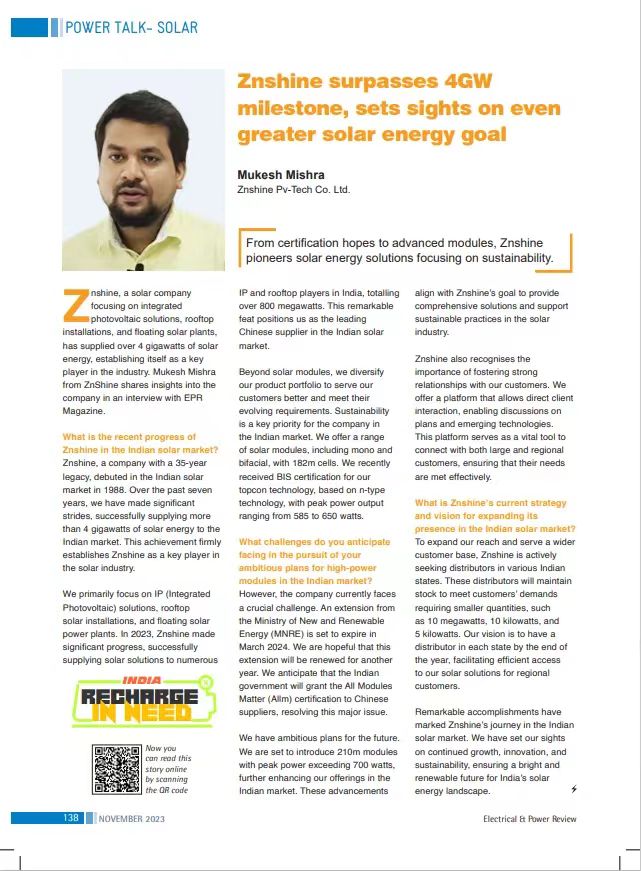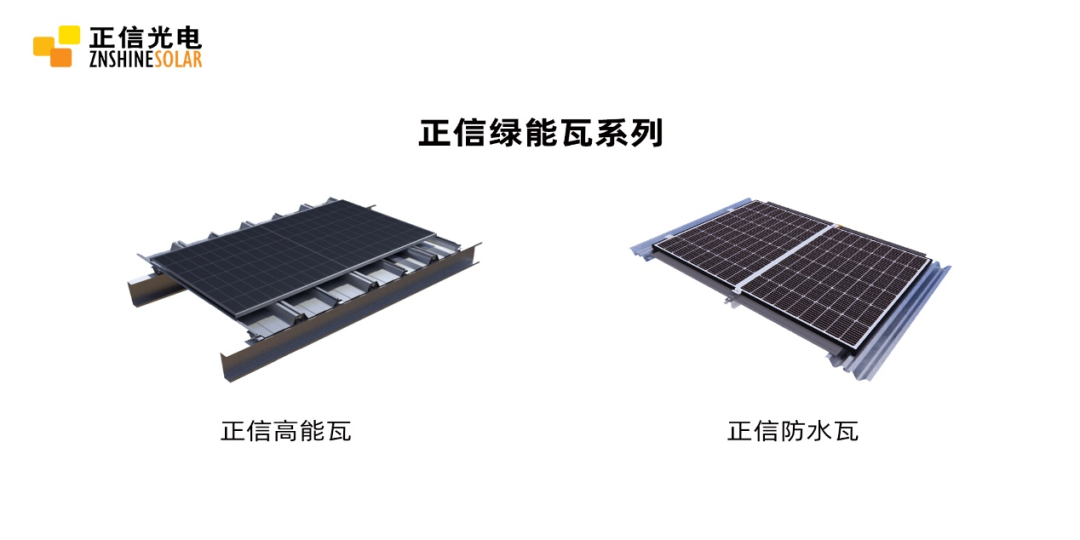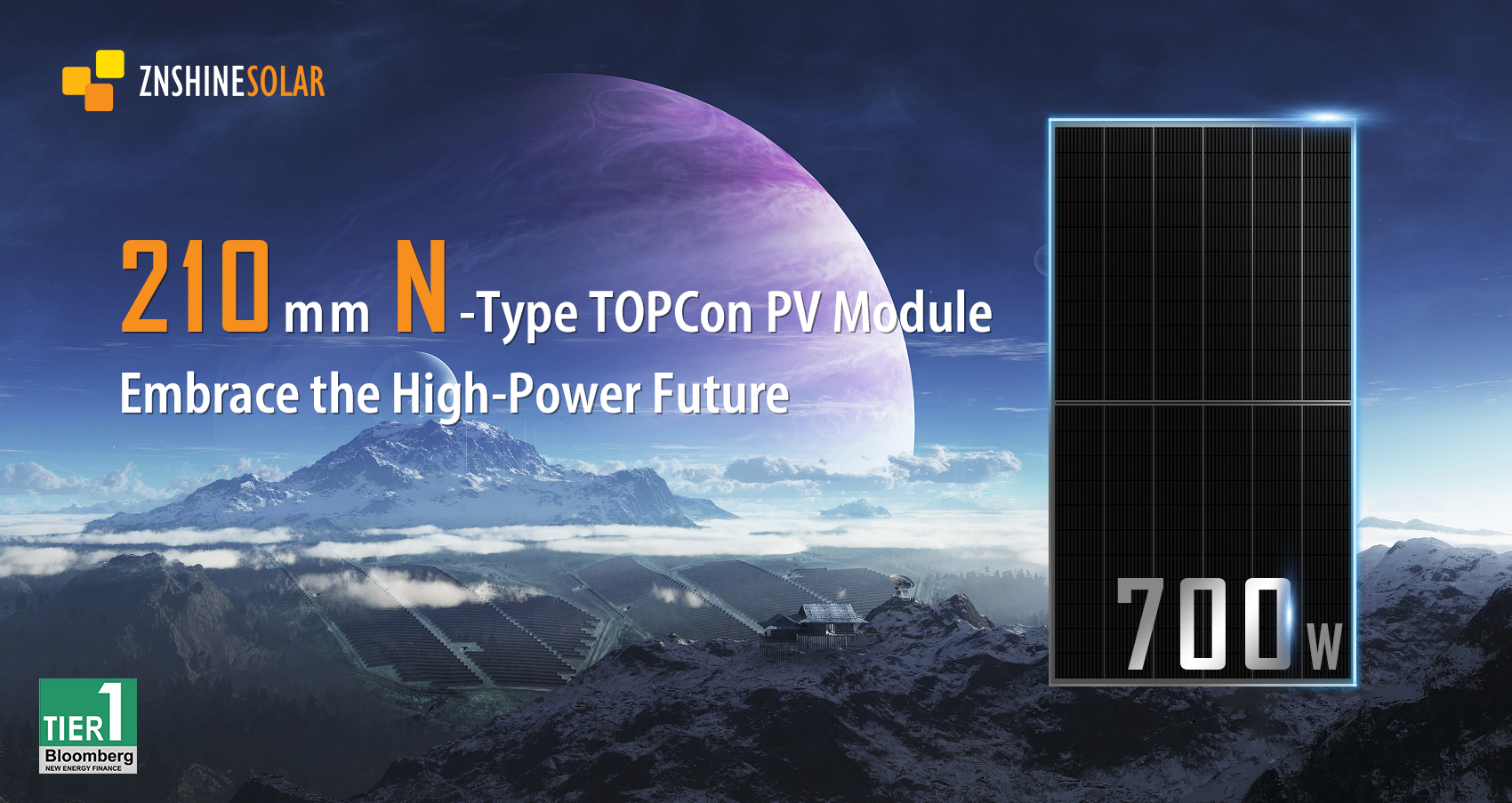Customer Support
T:+86 519 6822 0233
info@znshinesolar.com
info@znshinesolar.com
No. 229, Tongda Avenue, Suqian Economic and Technological Development Zone, Suqian City, Jiangsu
Views: 172 Author: Site Editor Publish Time: 2023-12-06 Origin: Site
Recently, Mukesh Mishra, the Sales Director for ZNSHINE SOLAR in India, was interviewed by "Electrical & Power Review" magazine to delve into the latest developments, strategic planning, and future vision of ZNSHINE SOLAR in the Indian market.

According to the 2023 fiscal year Renewable Energy Updates report by JMK, the renewable energy market in India is rapidly expanding. The Indian government's plan includes initiating tenders for at least 50 million kilowatts of renewable energy projects annually from the fiscal year 2024 to 2028, with a predominant focus on solar power projects.
Director Mukesh Mishra highlighted ZNSHINE SOLAR's leading position in technology and services since its establishment 35 years ago. In India, ZNSHINE primarily focuses on integrated photovoltaic solutions, rooftop solar installations, and floating solar power plants. Over the past seven years, the company has successfully supplied over 4 GW of photovoltaic solutions to the Indian market, solidifying its crucial position.
During the interview, Director Mukesh Mishra revealed that the company has supplied over 800 MW of capacity to multiple integrated photovoltaic and distributed power station operators, establishing itself as a leading Chinese supplier in the Indian solar market. Beyond strengthening existing product lines, the company continues to expand its portfolio with efficient modules and product diversification.
Since becoming the top Chinese module supplier in India in 2018, ZNSHINE SOLAR has consistently deepened its presence in the local market. The company has solidified strong business relationships in India, providing high-quality modules for multiple large-scale power stations, earning high trust from customers. In the second quarter of the 23rd year, ZNSHINE SOLAR maintained its leading position among Chinese module companies in the Indian solar field.

In terms of products, ZNSHINE SOLAR not only continues to offer solar modules but has also made significant progress in product innovation. The company has developed the patented ZNSHINE Green Energy Tile, a BIPV concept, and independently developed new products such as N-type N type16 grid high-efficiency, high-power modules based on the PERC platform, and PVB high-transparency colored dual-glass modules. These innovations strongly support the company's competitive advantage in the Indian market.

Facing challenges from policy adjustments by the Ministry of New and Renewable Energy (MNRE) in India, Director Mishra expressed confidence in the future. The company plans to introduce cutting-edge technologies such as 700W high-power 210mm modules while strengthening channel partnerships and establishing regional distributors in major states to better serve regional customers. The strategic plan involves expanding market share and coverage by seeking distributors in each Indian state, with the vision of having a distributor in every state by the end of the year.
"Where there is SUNSHINE, there is ZNSHINE." ZNSHINE SOLAR will continue to contribute to the renewable energy cause in India, actively supporting the sustainable growth of the Indian photovoltaic industry. The remarkable achievements ZNSHINE SOLAR has attained in the Indian solar market lay a solid foundation for future growth, innovation, and sustainable development, painting a bright and sustainable future for the Indian solar landscape.
The ZNSHINE Integrated PV, Energy Storage, and Charging System is built around the core concept of efficient and intelligent energy management, combining photovoltaic, storage, and charging functionalities. Tailored for residential, commercial, and industrial applications, this all-in-one clean energy solution leverages ZNSHINE's extensive expertise in the photovoltaic industry. Its flexible modular design caters to diverse application scenarios, significantly enhancing energy utilization efficiency while providing users with a low-carbon, convenient green energy experience.
In line with the global trend of energy structure adjustment and low-carbon development, ZNSHINE SOLAR introduces the ZNSHINE Integrated PV, Energy Storage & Charging System. Through technological innovation and efficient management, the off-grid mode of the system has become a new solution to address energy challenges in remote areas and regions with weak grid coverage. The ZNSHINE Integrated PV & Energy Storage System integrates photovoltaic power generation, energy storage, and intelligent control, offering high reliability and strong adaptability to provide users with sustainable clean energy solutions.
Industrial and commercial energy storage systems, as innovative power management solutions, are transforming the way businesses and enterprises utilize energy. By storing electricity during off-peak hours and discharging during peak times, these systems help reduce energy costs while serving as emergency power sources to ensure continuous supply during unexpected outages. This article delves into the energy storage segment of ZNSHINE’s Integrated PV&ES&CS System, showcasing its unique features and application advantages.
In recent years, the rapid development of solar photovoltaic (PV) technology has been accompanied by the continuous iteration of solar cell sizes. From the early 156mm era to today’s widespread use of larger 182mm and 210mm cells, each technological advancement has driven improvements in module power and optimization of system costs.
Graphene is hailed as the most revolutionary material of the 21st century, earning the title of "king of new materials" due to its exceptional properties. Composed of a single layer of carbon atoms arranged in a honeycomb lattice, graphene exhibits a range of remarkable physical characteristics. It is 100 times stronger than steel and has excellent electrical conductivity, with its carrier mobility at room temperature being approximately 10 times that of silicon. Additionally, graphene boasts outstanding thermal conductivity, with a thermal conductivity coefficient of up to 5300 W/mK, far surpassing most materials. Graphene is also nearly transparent, with an absorption rate of just 2.3% in the optical range. It retains excellent flexibility, allowing it to bend and deform while maintaining its structural integrity. These unique properties make graphene a material of enormous potential across various fields and are widely believed to herald a materials revolution.
When purchasing solar modules, performance and price are the two key factors to consider. The performance of a solar module depends not only on its photovoltaic conversion efficiency but also on the strength and durability of its structure. As a crucial support and protective component, the frame material has a direct impact on the overall performance of the module. Additionally, solar module frames, being high-value auxiliary materials, play a significant role in the module’s total cost structure. For instance, *the commonly used aluminum frame, with its strong mechanical properties, accounts for around 13% of the total module cost—surpassing other auxiliary materials like EVA, glass, backsheets, and solder ribbons—second only to the 55% cost share of the solar cells themselves.
Installing a solar photovoltaic (PV) system on a roof is a crucial process that requires ensuring the system efficiently captures solar energy while maintaining its safety and stability. This article will describe how to use the SRS (Solar Racking System) to install PV modules more securely and efficiently.
Una célula fotovoltaica es algo relativamente sencillo. Un material semiconductor, en el que se ha creado un diodo (se le ha dado polaridad), al que se le pone una capa azul antirreflejante y se conectan unos conductores eléctricos para extraer la electricidad. Digamos que la arquitectura de la célu